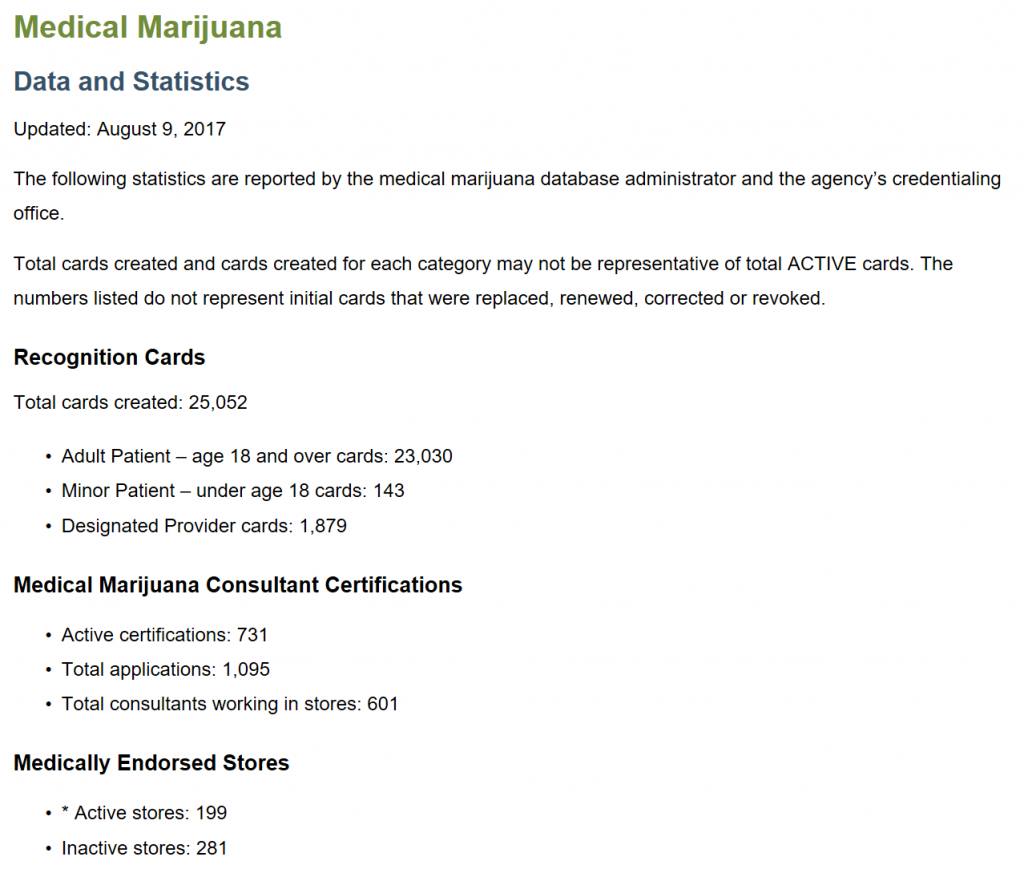As of this past Wed. (Aug. 9), the Washington State Dept. of Health has released data which indicate that over 25,000 people are now in their patient registration database.
If you ever want an update on how the regulated medical infrastructure is rolling out (now 13+ months into it’s infancy), check out the DOH Statistics and Data page here
In the meanwhile, here is what the DOH has to say, followed by a tiny bit of context-setting, courtesy of moi.
This represents 0.35% of all Washingtonians (or 1 in 287).
It represents 0.45% of all Washington adults (or 1 in 223). Note that these are”adults” of the 18+-year-old kind, per the medical rules.
Finally, it represents 0.009% of minors under the age of 18 (or 1 in 11,386).
Not all that many, on a per-relevant-capita basis. Indeed, fewer than 10% of what BOTEC estimated to be in existence before the regulated market started up.
By way of external reference these numbers are still (after 13 months) about 1/5 of what would be expected of adult patients if folks were registering at the same rates seen in Colorado or Oregon. For children, Washington is seeing only about 1/3 of the expected registrations, relative to these two other pioneering states.
I wonder if the fact that fewer than 200 Retail Access Points are currently considered able to serve Patients as Patients might be involved in our relatively low uptake?
For the 25,000 of you brave enough (and/or desperate enough) to have registered, keep an eye out for a series of upcoming Patient Service Announcements (PSAs) here on HI-Blog.
I’m going to try to start giving you information that will help you to identify stores and farms that might better meet some of your well-defined needs (and please understand that I am not being paid for this stuff other than through good Karma).
Request: If you want your well-defined patient-specific needs well-defined when I do the data work underlying these PSAs, please feel free to leave your input on what is important for Patients to know about the Retail Access Points at which they shop and the farms and processors whose products they purchase. Seriously …. my upcoming work will better fit your needs if you let me know what they are. Otherwise I’m just guessing and, as my regular readers can attest, that can be dangerous.
Cheers – and good health.
I look forward to hearing from you.

Are there any incentives given by the state for growers to cultivate high CBD strains?
Happy New Year, Darryl!
Washington does not offer any incentives of any kind to growers — let alone for those cultivating “high-CBD” strains.
When the established medical market was forced into the regulated system 18 months ago, a special “High CBD” product label was created by DOH for product defined be in compliance with language found in WAC 246-70. These products are typically low in THC and have relatively high CBD/THC ratios, and are constrained to relatively low maximum potency levels. They can be sold by any store (with or without an active Medical “Accreditation” by the DOH) and can be sold to non-patients, as well as to Patients.
All potency tests results are required to include CBD, CBDA and CBD Total (fully decarbed CBD) levels. These are done for all products sold at retail (or on their raw ingredients).
To go a bit further, any growers wishing to grow to the DOH-Certified “Medical” standard are required to do more extensive testing on their product (including testing for pesticides and heavy metals). On top of the additional expense of such testing, an additional downside of applying for such certification is that product failing either of these two QA tests MUST BE DESTROYED. Wholesalers can’t extract from it or otherwise remediate it or sell it into the non-medical regulated market.
They cannot sell it into the same regulated State-legal Cannabis market that requires no such testing of any of the other stuff that it does sell hundreds of millions of dollars of each year.
With that in mind, and assuming that at least some of those producing High-CBD products might be the type of folk that would like to produce to the higher “Medical Grade” standard, I’d have to conclude that the state actually dis-incentivizes High-CBD production a little – albeit indirectly.